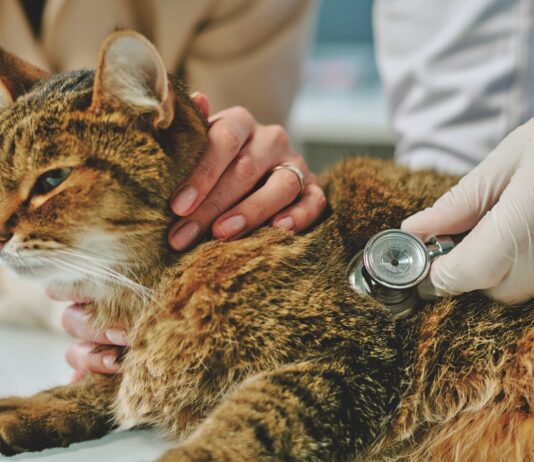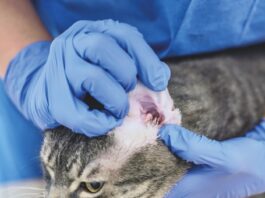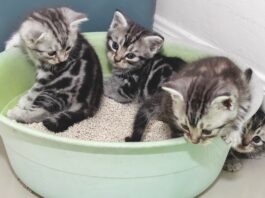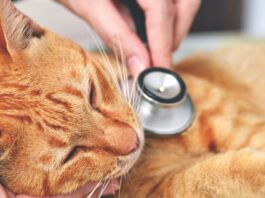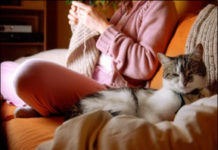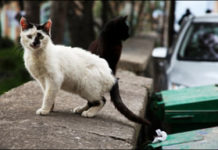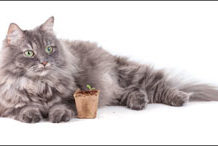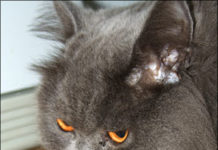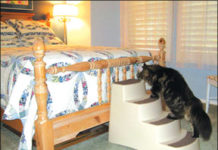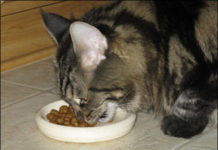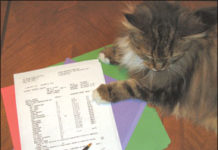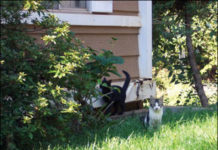Five Myths About Heartworm
One mosquito bite can infect a cat with heartworm, a potentially destructive and insidious disease, which reveals itself as H.A.R.D. (Heartworm Associated Respiratory Disease). The American Heartworm Society (AHS) and the American Association of Feline Practitioners (AAFP) have teamed up to get this urgent message out to cat owners through the KNOW Heartworms campaign (www.knowheartworms.org). Experts now feel that heartworm prevention in cats is extremely important because the dangers of heartworm disease are much more significant that previously believed. Here are five common myths about heartworm disease that can put your pet at serious risk.
Vomiting: When to Take it Seriously
You hear a familiar retching sound in the kitchen. Striker is vomiting up his dinner again. As you walk downstairs to clean up the mess, you wonder if its just hair balls - or something more serious that requires a trip to the veterinarians office. Cats vomit for numerous reasons, ranging from benign dietary indiscretion to potentially fatal systemic diseases such as renal failure or hyperthyroidism. The experts say that cat owners should pay close attention to a cat that regularly becomes sick to his or her stomach. Be Observant. "When it comes to vomiting, the important concept for cat owners is observation," advises Fred Scott, DVM, PhD, interim director of Cornells Feline Health Center. "Vomiting in association with signs of systemic illness must be addressed rapidly." Signs include lethargy, fever, loss of appetite or weight loss. Even if the cause of vomiting is transient or self-limiting, loss of fluids and electrolytes can have life-threatening consequences.
Short Takes: 07/09
Legislation in California that seeks to mandate spay and neuter surgery for most cats and dogs has been placed on the suspense file pending further review. Senate Bill 250, introduced in February by Sen. Dean Florez, requires that dogs be spayed or neutered unless their owner gets an unaltered dog license. It also requires that roaming cats be spayed and neutered. The Senate Appropriations Committee analysis on SB 250 states that the bill has costs associated with it in the short term. As a result, it was placed on a list with other bills which have a fiscal impact on state and local governments. All bills placed on the suspense file are scheduled to be taken up together at a later date. Staff and lawmakers review all bills that are projected to cost more than $150,000, and then decide which bills will be released to the committee and voted on.
Diagnosis: Bladder Stones
Your cat normally uses the litter box a few times a day to relieve herself, but today is different. Shes going to the box every few minutes and vocalizing as she strains to urinate. The small amount of urine that finally dribbles out is filled with blood. Your cat may be suffering from bladder stones, a painful condition that, left untreated, can lead to serious illness and in rare cases, death. Causes of Bladder Stones. Bladder stones, or uroliths, are caused by an extensive concentration of salts and minerals in the urine such as magnesium, phosphorous, calcium, and ammonia. "There should always be a certain amount of salts and minerals in the urine," says Richard Goldstein, DVM, an associate professor of small animal medicine at Cornell Universitys College of Veterinary Medicine. "But when the urine becomes super saturated - meaning theres an overabundance of salts and minerals - crystals begin to form."
Protect Your Plants and Keep Kitty Happy: Grow Grass Indoors
Everyone knows that cats are carnivores. So why does your cat keep snacking on the houseplants? Some experts say greens help cats get rid of hairballs, others that cats crave the fiber and moisture. There may be a nutritional component as well: when feeding on prey, a cat will eat the intestines first, where its likely to find plant matter. But regardless of the reason for the craving, plants can prove a serious danger to cats. Many common houseplants, such as lilies, asparagus ferns, and foxglove, are poisonous. Outdoors, a cat may eat grass or other plants contaminated by pesticides and fertilizer.
Ask Elizabeth: 06/09
The dark brown color of normal cat stool largely results from substances in the bile, a liquid produced in the liver that then empties into the first part of the small intestine. Bile aids in the digestion of fats and contains a number of substances, among which are breakdown products of aged red blood cells. These breakdown products impart the yellow color that is characteristic of bile. As these yellow pigments pass in stool on the way out of the body, bacteria residing in the large intestine break them down further, so their original yellow color is changed to a dark brown.
Is Your Cat Slowing Down?
At the age of 12, your cat seems to be slowing down a bit, and that could be perfectly normal. After all, a cat of her age - equivalent to the age of 65 or so in a human - has been living a full life and deserves to take it easy on herself. Nevertheless, its a good idea to have the animal checked out by your veterinarian. Its quite possible that her diminished activity is a consequence not of her advancing age but of a debilitating pain in one or more of her joints. Slowed-down, reclusive behavior is an indication of a joint problem in cats of any age, says Christine Bellezza, DVM, a consultant at the Cornell University's College of Veterinary Medicines Feline Health Center. "Some of the signs are very subtle," she points out. "An affected cat may seem lethargic and may increasingly seek out comforting places to nap - in a warm corner of your home, for example, or in a spot of sunshine near a window." The reclusive behavior can also be attributed to a deeply ingrained feline instinct for self-protection. A cat may want to conceal its disability for fear of alerting a potential predator to its vulnerability. Other indications that a cat is suffering pain in one or more of its joints may not be so subtle. "The cat may have trouble hopping in and out of its litter box," says Dr. Bellezza, "and it may avoid going up and down stairs." It is also possible for a cat with a severe joint problem to become constipated because it cant position itself properly to defecate. Furthermore, due to joint pain, an affected cat may be unable to groom itself thoroughly.
Cats and Extreme Stress
Two years ago, Alex McCarthy adopted a lively, affectionate kitten from a shelter in New York City. Alex, her cat Kit and two roommates lived harmoniously in a tiny New York apartment. Then Alex decided to move with Kit to an apartment of her own. "The day the movers came, Kit was terrified," says Alex. Once they were settled in the new apartment, Kit was never the same. She would only allow Alex to go near or touch her. When visitors came, she would run up and sniff them, then hiss. If they attempted to pet her, she would lash out at them with her paws. Sometimes, she even scratched them. Now its people who are terrified of Kit. What happened to the sweet kitten? She may be suffering from post traumatic stress disorder (PTSD), which can occur after a very stressful or frightening event - just as it can with humans.
Bothersome Eating Behaviors
One cat knocks its food bowl over and makes a mess on your floor every time it eats. Another cat is a thief. It hops onto your kitchen counter at any opportunity to snatch whatever morsel of food it might spot lying there. A third cat spends a good part of its time gnawing on the clothing it finds in your closet. These are among the more common, puzzling, and often very annoying feline eating-related behaviors that, if not appropriately addressed, can seriously compromise the relationship between a cat and its owner. Some such unusual activities, says Katherine Houpt, VMD, James Law Professor of Behavioral Medicine at Cornell University's College of Veterinary Medicine, can signal the presence of a serious physical disorder and will thus merit the attention of a veterinary nutritionist. Others are merely goofy habits that the cat has picked up and can probably be rectified by an owner. And still other undesirable eating habits may stem from deeply rooted "neurotic" problems that can only be successfully reversed with the help of an animal behaviorist - sometimes with the help of certain feline anti-anxiety medications. When is it time to seek the advice and guidance of a behaviorist? "Certainly if the animals habits are seriously endangering the cat-human bond," says Dr. Houpt. "This is an especially urgent matter if the owner is thinking about abandoning a cat to a shelter or, even worse, having it euthanized. Likewise, an owner should seek behavioral consultation if the eating behavior - consuming indigestible materials, for example - could pose a physical threat to the animal."
The Pleasures (and Perils) of Catnip
Planters of catnip, beware! This perennial is a member of the mint family, like spearmint and oregano, and it reproduces by spreading runners beneath the soil Put one catnip plant in your garden and in five years it may well have taken over. Veteran gardeners plant catnip in buried containers, or in above-ground pots that even the hardiest and most aggressive roots cant escape. Despite the voracious nature of the plant, its worth having around. Carolyn McDaniel, VMD, a consultant at the Feline Health Center at Cornell Universitys College of Veterinary Medicine, says, "Catnip is non-toxic, non-addicting, and low calorie … I think catnip can be a valuable part of an indoor cats environmental enrichment." The entire catnip plant - stem, leaf and seed - is covered with microscopic bulbs that contain nepetalactone. When these bulbs (at the end of sharp hairs called trichomes) reach maturity, they burst, releasing the oil, which then vaporizes upon exposure to air. Just like poison ivy, brushing against the leaves bruises them enough to release the oil from the trichomes, which is why you might see your cat leaning into the catnip. The oil can also be released by insects chewing on the leaves - or by a cat doing the same.
Feline Pancreatitis: Serious
Although the feline pancreas is a relatively small internal organ, typically weighing no more than six or eight ounces, it plays a demanding and multifaceted role in maintaining a cats robust health. Indeed, a disease or injury that results in the inflammation of this vital organ - a condition called pancreatitis - could prove fatal unless the animal receives prompt, and potentially quite expensive, medical care. The pancreas is a slender, pink, v-shaped strip of tissue resting snugly within the cats abdomen between its left kidney and its duodenum. It is a glandular organ that performs two life-sustaining functions-endocrine and exocrine. While still in the pancreas, explains Richard Goldstein, DVM, an associate professor of small animal medicine at Cornell Universitys College of Veterinary Medicine, these digestive enzymes are normally sequestered in tiny droplets that prevent their coming into direct contact with pancreatic tissue. Moreover, he says, the enzymes are biologically programmed to remain inactive until after they have been secreted and have traveled via the pancreatic duct into the small intestine.
Hark, Who Goes There?
Quite often, I am told tales of apparently mild-mannered cats that seem to tolerate all of lifes challenges save one: the Trespasser. When face to face with a Cat Errant, Mr. Mellow just cannot cope. We are all cat lovers and certainly wish no harm to our neighbors cats. But naturally, we want to look out for our family. When a resident cat spies a potential intruder, several responses are possible. If you are lucky, your cat might believe that the more, the merrier. He may chirp, he may posture in a beckoning manner, or he may continue to nap calmly, with no apparent interest in the antics of his comrade through the glass. If you are less lucky, you may find that your cat does not trust that the glass is sufficient to keep an offending cat at bay. He may post "Private Property" signs of his own. You may come home to discover that your windows and doors have been marked with urine. If you manage to get through the winter months unscathed, beware the ides of April. For when the windows are opened for a little fresh air, the urgency to reset the barriers will return. The most concerning cat of all is the cat that experiences profound fear upon viewing an unfamiliar cat. The frightened cat may respond by redirecting aggression toward a member of your household. Although other cats are most frequently targeted, other pets and people may find themselves victims of serious attacks. The impact on a relationship can be devastating. Fortunately, you can intervene. You will need to work with both sides of the equation.

